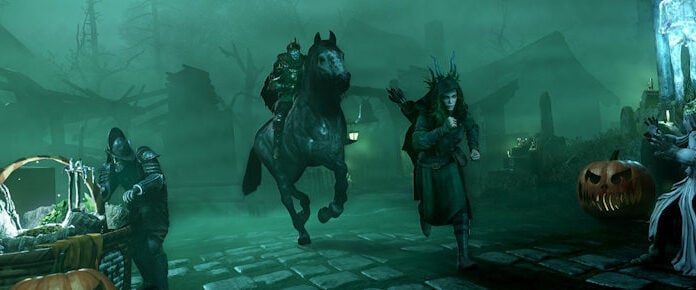
It’s been a banner year for The Elder Scrolls Online. From events galore to the release of the dragons, so much has happened that it’s easy to forget some of the little details along the way. I thought it might be fun to take a glance back to remind ourselves of some of the major ESO stories of the past year. So sit down by the hearth, grab a spiced matze and enjoy this 2019 retrospective of The Elder Scrolls Online!
Back what seems like ages ago – so, you know, January – ESO provided official details about the major incentive to participate in events for the upcoming year: the indrik evolution. Players would be able to collect event tickets via myriad in-game events to spend on different kinds of feathers and berries in order to collect different cosmetic variations of this unique mount. While somewhat overly complex, enthusiasm for the indrik evolutions was initially high until event fatigue inevitably set in. Some players decried the inclusion of event tickets in the crown store, and some gave up collecting indriks altogether as other, less repetitive content was released throughout the year.
In February, fans of the lore were disappointed to learn that much-beloved Elder Scrolls loremaster Lawrence Schick would be leaving his position for family reasons. In true Schick fashion, his farewell letter focused on the Elder Scrolls community and looking ahead instead of his history and accomplishments.

In March, ESO’s first major update of the year launched. Titled Wrathstone, the major focus of the update centered around two new dungeons: Frostvault and Depths of Malatar. This update also kicked off the ambitious “year of the dragon,” a yearlong story arc that ran through each of the four quarterly updates but that could also be played separately if the player so chose. The DLC also included a new Battleground PvP map called Eld Angvar. The update brought some nifty quality-of-life improvements for all players. A zone guide was included in each open landscape zone to help guide players through zone stories that sometimes got lost in the mounds of other zone activities. The guild trader UI was overhauled to allow more intuitive interactions for trading guild sales. Also in March, we were introduced to new ZeniMax loremaster Leamon Tuttle.
In a wildly popular April 1st post, ESO trolled us with the idea of providing real-life cat costumes in the Bethesda Gear Store, modeled after some of the in-game outfits available for the Alfiq furstock of Khajiit. Costumes included the Industrious Alfiq Merchant and the Indolent Alfiq Freeloader. While most recognized the post as an April Fools’ Day joke, many players lamented that they could not, in fact, dress their cats in these adorable costumes.

In May, ZeniMax released a video of actor Alfred Molina detailing his portrayal of Grand Chancellor Abnur Tharn. It was fun to see some of the lines from the game being read by Molina knowing that they were going to be included in the upcoming major chapter release, Elsweyr.
In June, Elsweyr itself launched. This chapter release included the large landmass of Northern Elsweyr and a new main quest line that followed some of the more memorable characters from the original ESO main quest. Because the main point of the story dealt with dragons being released from an ancient prison, the new dynamic event mechanic involved dragon world bosses spawning in pseudo-random locations throughout the new land. These world bosses were designed specifically to be some of the most difficult non-dungeon content ever released in order to encourage large groups of players to cooperate to achieve victory. Elsweyr also brought a new class, the Necromancer. Those who chose this class for a player-character were able to call forth the spirits of the dead to aid in combat. Necromancy, mainly shunned as taboo in the world of Tamriel, brought with it a challenge both to developers, who wanted to ensure that townspeople reacted to necromantic events with appropriate horror, and to players who had long considered Necromancers to be the opposite of heroes.

In mid-June, ZeniMax released free update 22, which included tools for advertising and joining guilds. Personally, I think this is an underrated and perhaps even underused feature within ESO. Instead of relying on outside recruiting websites, forums, or spammy chat sessions, players of the Elder Scrolls Online can browse various guilds within the game to find one that fits their needs and apply to said guild directly through the in-game tool. I’ve personally used this avenue to find a new trading guild when mine decided to boot me for being too poor.
In July, we heard from the developers of ESO at Quakecon 2019. This lengthy panel included some interesting tidbits and stories from the inception of the game through present day. As far as new information was concerned, the dev team introduced us to a massive performance improvement plan, which included efficiency gains in load screens, damage over time server impacts, and dungeon finder activities. To date, some of these improvements are still being hashed out and some still have yet to be implemented.
Just in case we thought the dragon threat was contained after Elsweyr, in August we received the Scalebreaker DLC along with update 23. They included a continuation of the year of the dragon story arc along with some additional QoL improvements. Lead dungeon designer Mike Finnigan again frustrated players (in a good way!) with two new dungeons, Lair of Maarselok and Moongrave Fane. The free update improved the way undaunted keys and rewards worked within the game, as well as multi-crafting, which allowed for the processing of multiple crafting items at once as opposed to sitting at the crafting station and pressing the “process” key over and over and over. For trading guilds, ESO also added the ability to bid on multiple trader locations at once, which I’m still not sure is a good thing.

In October, the Season of the Dragon finale, Dragonhold, launched. Dragonhold completed the land of Elsweyr by including the smaller, albeit somewhat more colorful, Southern Elsweyr region. Dragonhold leaned heavily into the lore of an ancient order of dragon hunters, the Dragonguard. Unfortunately, the year-long story finale was a bit overshadowed by the simultaneous release of the first round of performance improvements which included a substantial damage decrease to all damage-over-time skills.
In November, faced with continued issues concerning the in-game event finder, ZeniMax was forced to re-arrange the end-of-year events schedule when it became clear that events relying on the finder would be heavily impacted.
This month, ESO announced that we will be hearing more about future game enhancements on January 16th. While the announcement included no hints about future content, we’ve all heard a lot of speculation.

Whew! That’s a lot of stuff packed into a single year. I’m sure there are some that I’ve neglected to mention as well. While some of the notable events are good and some are not so good, one thing is for sure: this MMO does not appear to be slowing down. Best of luck to ESO as we progress into 2020!
 Traverse the troubled land of Tamriel in the Elder Scrolls Online! Larry Everett and Ben Griggs will be your guides here in Tamriel Infinium on Wednesdays as we explore together the world created by ZeniMax and Bethesda in one of the biggest MMOs in the genre. Larry and Ben welcome questions and topic ideas!
Traverse the troubled land of Tamriel in the Elder Scrolls Online! Larry Everett and Ben Griggs will be your guides here in Tamriel Infinium on Wednesdays as we explore together the world created by ZeniMax and Bethesda in one of the biggest MMOs in the genre. Larry and Ben welcome questions and topic ideas!














